Glossary
A
Abaca: A bast fibre, rather like hemp, grown in the Philippines, used mainly for cordage.
Absorbency: The amount of moisture the fibre or fabric can absorb.
Acetate: A man-made fibre from the cellulose found in cotton and / or wood pulp. It is fast drying and not easily creased. It is often a sumptuous looking fabric imitating silk. Acetone or alcohol will melt the fabric.
Acid Dye: A colouring solution for protein fibres, acrylic, polypropylene and nylon fabrics made with an acidic base. It is resistant to fading in sunlight and will not run in the wash.
Acrylic: A man-made fibre that consists of synthetic polymers, acrylonitrile. It has a soft, woolly texture. It is not very absorbent, doesn’t crease easily is quick drying, soft yet tough. It can withstand direct sunlight and chemicals.
Adjective Dye: A dye which requires the use of mordents.
Alizarin: A rich red dye, once made from the root of the madder plant but mostly now made from chemicals.
Alpaca: Part of the llama family native to South American. It is has a fleece that is softer, finer but stronger than ordinary sheep’s wool. It is technically a hair not a wool fleece. It was once a specialty fibre but is becoming quite common with the popularity of the animal spreading across the globe. Farmers in Australia often keep an alpaca or two to chase away wild dogs and other predators from their sheep flocks.
Alum: A commonly used mordant made from hydrated double-sulfate of alumina potassium
Amercian Pima Cotton: A cotton grown in Arizona, USA. It is a cross between Sea Island (considered the finest cotton) and Egyptian cotton.
Ammonia: An alkaline liquid used in natural dyeing.
Ammonium Sulfate: A chemical which makes an acid-forming salt. It is used with acid based dyes.
Alpaca scarf.
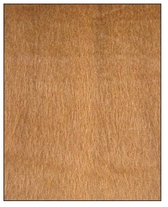
Aniline Dyes: Also called coal tar dyes. It is an early synthetic dye that was once extracted from aniline (coal tars). The term is now used to refer to all classes of synthetic organic dyes as opposed to dyes with an animal or vegetable base and synthetic inorganic pigments. Aniline dyes are graded according to their brightness and their resistance to light.
Animal Fibres: Hair from animals used to make textiles: wool, fur, cocoons and hair.
Angora goat: The fleece from this animal is called mohair. It is a luxury fibre that has a lustrous appearance.
Angora rabbit: A rabbit that is native to Asia Minor and Turkey. The fur is long and fine, light weight and fluffy. It has a tendency to matt and to shed hair. It has to be blended with another, longer haired fibre, such as wool, in order to be spun or felted. It is sometimes used to make felt hats.
Anthrax: or ‘wool sorter’s disease’ is a highly infectious and often fatal disease caused by Bacillus anthracis. It got its popular name through the fact that people who regularly handled fleeces were often at risk of contracting it through any cuts in their skin coming into contact with infected animals.
Apparel Wool: Wool that is specifically used for making garments.
Applique: Stitching one piece of fabric on top of another to form a design. Reverse applique requires two or more pieces of fabric placed together and the top layers cut away to reveal the lower ones to form a design.
Aramid: Is a man-made fibre that is flame proof and cannot melt.
Assisi work: Is a counted thread embroidery where the central motif is outlined and the background filled in with embroidery stitches so that the motif is a negative shape. Originated in the town of Assissi in Italy.
Astrakhan: True Astrakhan is the skin of a caracul lamb from the Astrakhan area of Russia. The black curly texture has been imitated by using wool sometimes woven using a mohair warp. A pile is woven and then cut to simulate the soft curly wool.
Attenuation: The act of drawing carded fibres from the distaff into a strand of a particular thickness.
Axle: The central shaft of a spinning wheel.
Axminster: A town in England which was the original home of the Axminster carpet made from wool.
B
Baby Combing Wool: or French Combing Wool as it is also called is a worsted wool yarn, characteristically short and fine.
Backlining: The application of a louse-killing chemical along the backbone of a sheep.
Backstrap loom: A loom that uses the weaver’s body to supply the necessary tension for the warp threads. It is held in place by a belt.
Bactrian Camel: The type of camel which produces hair that can be made into textiles.
Balanced: A plied yarn that doesn’t twist back on itself. If you over twist a yarn you will find that it will want to double back and twist up its own length.
Bale: The measurement and packaging in which Australian and New Zealand Wool have their fleeces made into. Each bale weighs 150 kg (330 lb). In the US they are called ‘bags’. This is to facilitate transporting. Cotton is also made into bales for shipping, they weigh approx 226 kgs (500lbs).
Banana fibre: A popular Asian fibre taken from the stem of the tree, not the fruit, and made into textiles and paper.
Basic Dyes: These are usually synthetic dyes that form bases for other dyes. They are aniline dyes. If the base is converted into a salt then it may become water soluble.
Basket Weave: a type of weave that has a characteristic basket-like appearance.
Bast: A fibrous plant whose stem consists of a hard outer coating and bundles of fibres inside. Hemp and flax are both common bast fibres.
Baste: A temporary form of stitching to hold fabric in place while a more permanent process is used to fix the pieces together. For instance in tailoring, collar faces are often basted in place before the sewing machine stitches them together. It is also referred to as ‘tacking’.
Batik: A decorative process involving wax and dye. Melted wax is applied to a cloth to cover areas of the pattern not to be coloured. The piece is then immersed in the dye bath. When this has dried more wax may be applied to areas that need to retain that dye colour. At the end of the process the wax is removed through heat.
Baptiste: Named after the French linen weaver, Jean Baptiste this light weight, semi-sheer fabric is made from cotton, rayon or wool. It is woven from tightly twisted yarns with a mercerised finish.
Batt or Batting: Padding or stuffing made out of wool, cotton, manmade fibre or a combination of these which is made into sheets. It is often used in quilts between the decorated outer layer and the practical under layer. Its primary use is to add warmth.
Beading: A surface decoration where beads are sewn onto the fabric.
Beaver cloth: An English textile made to imitate beaver fur. It is made from wool or cotton and is napped on both sides. It has a twill weave that is heavily napped and then fulled. It is a heavy luxurious fabric that is used mainly for coats.
Belly Wool: The fleece that grows on the underside of a sheep, hence its name. It is a different grade of fleece from that which grows on the back of the animal and is characteristically uneven in quality and has shorter, weaker fibres.
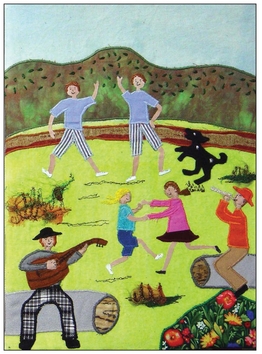
Applique.
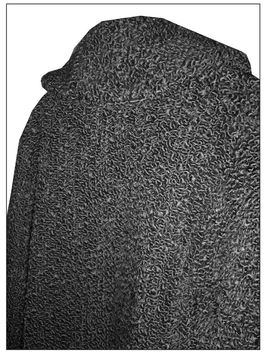
Woven Wool Astrakhan coat from the 1960s.
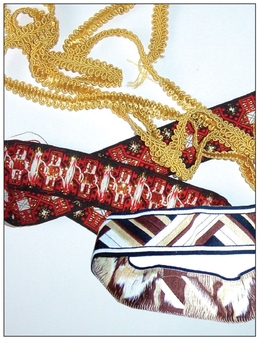
Machine-made braid.
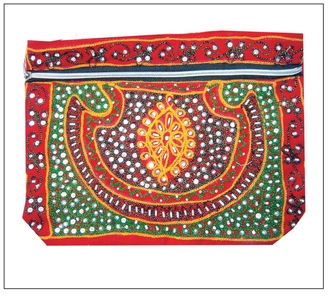
A heavily beaded bag.
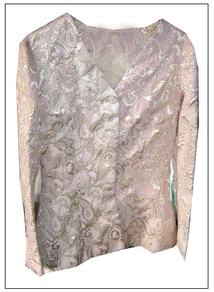
Upholstery Brocade.
Beetle and beetling: A large wooden mallet, the beetle, is used to soften and flatten cellulose fibres in woven fabric such as ramie and linen. It helps produce a lustrous finish to the textile. The process of pounding the fabric is called ‘beetling’.
Bias: When fabric is cut across the bias it means the warp and weft threads are on a diagonal, not straight up and down. This gives a stretch to the piece of fabric and good for using on necklines and other curved seams.
Binders: The individual hairs in a sheep’s fleece that run from one staple to another.
Binding Threads: Threads used to unite two or more ply into one composition.
Black Wool: Wool that contains coloured fibres. A fleece containing some coloured fibres, though predominantly white, will be put into the black wool pile. This will later be dyed a uniform colour.
Black-top Wool: Fleece that contains high quantities of natural grease that gathers at the ends of the wool staples and attracts dirt. It is often very good quality wool.
Blanket cloth: Made from a variety of fibres including wool, worsted, cotton and synthetics and blends of these. It is heavily napped by putting fabric over rollers covered in tiny wire spikes called teasels (after the plant it resembles). The textile is then fulled. It takes its name from the Flemish weaver Thomas Blanket (Blanquette) who lived and worked in Bristol, England in the Fourteenth Century. Blanket cloth is used for bedding and overcoats.
Blanket Stitch: An embroidery stitch that finishes the raw edge of the blanket fabric, acts a bit like an overlocker stitch in that it helps prevent the edges from fraying.
Bleaching: The removal of all impurities in fibre or a textile so that its whiteness is as bright as possible. It also refers to the total removal of colour from a textile but is not always the case.
Bleeding: When dye from fabric runs, often discolouring other fabrics.
Blend: A mixture of different fibres or grades of fibre in a piece of fabric or a yarn.
Blocker and Blocking: A frame used for drying skeins of wool. The damp yarn is wound firmly around the frame and left to dry. The skein can then be removed as a whole skein. The purpose is to dry it under tension. A similar effect can be achieved by winding the damp yarn around the legs of an upside down coffee table or chair.
Bobbin: The storage facility which yarn or thread is wound on to; traditionally a wooden spool. Domestic sewing machines use bobbins for the under thread. Bobbins are also used to make bobbin lace with.
Bodkin: A long, needle with a large eye, usually thick in diameter and bluntish or a small slim tool with a sharp point used for making holes in cloth or leather.
Body: Refers to the fullness and bounciness of fabric or wool staple.
Boiled Wool: The process for ‘fulling’ a piece of knitted wool fabric. The fibre mats together to form a solid, felt-like piece of textile.
Boiling Off: The process used for removing seracin from silk threads before they can be reeled.
Bombazine: The name comes from the Latin word bombycinum which means silky. Of course it is connected to the name of the moth from which silk is harvested, bombyx mori in China. Bombazine is an English textile, originally made of silk. It was popular in the Nineteenth Century as a mourning garment when dyed black.
Botany Wools: Derives its name from the fleece sent from Botany Bay in Australia. It now refers to high quality wool.
Bouclé: The name comes from the French word meaning buckled. It is a base yarn that has another, fancier twisted yarn wrapped around it to form loops and bobbles. It is also a fabric made with the yarn so that has a distinctive texture. It can be a heavy or light weight fabric depending on the weight of the yarn.
Braid: Is a form of interweaving threads, similar to plaiting. Is also the name given to a narrow, often continuous band of material with a decorative motif or design woven into it used to trim garments for decorative purposes.
Braid Wool: A coarse but lustrous wool, the coarsest grade of wool in the US.
Brandenburg: Decorative braid formed into a roll to make a fastening.
Breaking: The point in the process of removing flax fibres from its outer coating after it has a rollers or beaten with wooden paddles to break the fibre into a pliable substance. It is essential that the fibres are not damaged in the process. This is also called ‘scrutching’.
Breaking Load: The point at which a fibre, yarn or fabric will break under tension.
Breech or Britch Wool: Fleece of very poor quality that comes from the back end of the sheep. It is often very dirty. It can be cleaned and used for hand spinning.
Breed Characteristics or Breed Type: The particular characteristics of a particular breed of sheep, for instance Merino which is a fine, crimped fibre or the Lincoln, which has a much coarser fibre with less crimp.
Bright: Term used for ultra clean and white wool. Cormo is a breed that produces this kind of fleece.
Brittle: Refers to harsh, dry, ‘wire-like’ fibre; much like the split ends in hair.
Broadcloth: Originally made from the spun yarn of short stapled wool, it was woven on a broad loom and then fulled to make it thicker and more durable. It is napped and then closely sheared to give a velvety texture. Broadcloth was one of England’s major cloth exports. It is now sometimes made of cotton, silk or polyester.
Broadloom: An especially wide loom capable of weaving wider fabrics.
Brocade: Brocade is a jacquard weave with an embossed effect and contrasting surfaces. Can also be woven with synthetic or man-made fibres. Brocade is recognisable by its elaborate design in low relief and is often reversible so that the same figure appears on the reverse side but in the opposite colours (somewhat like a photographic negative).
Broderie Anglaise: A type of embroidery in which the fabric and thread are the same colour. Parts of the fabric are cut out to give a decorative, lacy type effect.
Brushed Wool: Fabric or yarn that is brushed to raise loose fibres to give a distinctive finish.
Buck Fleece: A fleece from a ram. The wool often has a heavy shrinkage rate because of the excessive oil in the fleece. This wool is not of the same quality as that of wool from ewes or wethers. It can also have a strong odour.
Buckram: A loosely woven fabric made in cotton or linen that is heavily sized to make it stiff. It is used for stiffening in clothes, such as in the collar or cuffs. It is also used to stiffen the brim of hats.
Bulk Grade: The largest percentage of grade in a lot of original-bagged wool.
Bump: Is a commercial measurement and delivery system for fibre. It consists of a cylinder of coiled fibre already for spinning.
Burlap: The American name for hessian.
Burry Wool: A fleece or wool fibre that is full of extraneous matter such as: burs, leaves, seeds, and twigs. It requires a lot of cleaning of these things in order for it to be used.
Bursting Strength: A mechanically applied strength test done commercially on fibres.
C
Calendering 1: Method of adding sheen to a fabric. For instance, if the fabric is dyed with indigo then one traditional method of calendering is to coat it with a mixture of egg white or blood and then beat it into the fabric until the sheen appears.
Calendering 2: The process of passing fabric through a machine consisting of heavy rollers, which rotate under pressure to smooth and flatten fabric, to close the intersection between the yarns, or to confer surface glaze. Often used with cellulose fabrics like linen and cotton.
Calico: Is one of the most common cotton fabrics available and one of the cheapest to buy. It is a coarse weave and is sized before selling to make it crisp. When the starch is removed calico can look rather drab. Calico originally came from Calcutta in India.
Cambric: A cotton or linen fabric that is closely woven. It is calendered on the right side to give it sheen. It originates from Cambria in France.
Camel Hair: Hair, mainly from the belly, of the Bactrian camel, which has two humps and is native to China and Mongolia. It is a soft, light and fragile fibre that makes a light but warm fabric that is water resistant and wrinkle free.
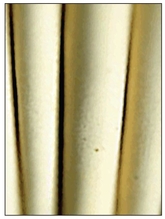
Calico.
Camelid: Any animal that comes from the camel family. Obviously camels, but also alpaca and llama.
Canary-stained Wool: A discolouration occurring in wool which may be caused by bacteria or urine It is difficult to remove this kind of stain by ordinary scouring and washing.
Candle: Is the fat on an unwashed fleece that stiffens as it sits.
Candlewick fabric: The base fabric is plain weave cotton or wool. Onto this candlewick (heavy plied yarn) loops is placed to form a design which is then cut to form a pile. It is often found made into bedspreads.
Canvas: A family of fabrics, usually made from cotton that have a heavier, more open weave made from plyed yarns. It is used to make things for heavy duty use and often is waterproofed to add protection. Artists also use canvas as a base for oil painting in which case it is covered with a layer or two of white sealant called gesso.
Carbonising: A chemical process for removing vegetable contamination from animal fibres.
Carded Fibres: Fibre, usually, wool, cotton or flax, that have been processed ready for spinning.
Carders: The brushes which are used in the carding process. For hand spinning, hand carders are used. For commercial spinning carding is done with large mechanised drum carders.
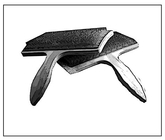
Carders.
Carding: A process involving the brushing fibres between two metal plates covered in bristles. The process rids the fibre of any contaminants such as burs or twigs, straightens the fibres and makes them parallel to each other. Once fibre is carded it can be spun.
Carpet: A heavy duty textile, often made of wool though also man-made fibres and in some cases silk. Carpets can be made by weaving or knotting short lengths of yarn onto a heavy open weave canvas.
Carpet Beetle: The larvae of the beetle that eats wool and other protein fibres.
Carpet Wool: A wool with coarse, heavy duty characteristics that will withstand the wear and tear of being walked on.
Cashgora: A fleece from the animal resulting from the cross breeding of cashmere and angora goats.
Cashmere: Is the fleece, or hair, from the Kashmir goat that is found in Kashmir, India, Tibet, Iran, Iraq China, Persia, Turkestan and Outer Mongolia. It is soft, silky and fine. It is a very good insulating fabric and doesn’t crease. Of all hair fibres this one is most like wool and tends to be rather delicate. It is a luxury fleece.
Castle Wheel: The flyer is usually mounted above the wheel to keep the wheel compact. It is similar in design to other portable spinning wheels.
Cellulose Fibre: Is made from the cell walls of plants such as: cotton, hemp and ramie.
Chambray: Is a plain weave cotton using a dyed warp thread and a white filling. It has a faded look. It was originally made in Cobrai in France and is used for dresses, children’s wear and aprons.
Chaffy Wool: Wool containing a considerable amount of chaff, that is, finely chopped straw.
Chain Stitch: An embroidery stitch involving looping the thread around the needle to form a chain like stitch. It is often used as a fill stitch in Indian embroidery.
Challis: This is a soft, lightweight fabric made from wool, cotton or man-made fibres. It was invented in Norwich, England in1832. The name comes from an Indian word, Shallee, meaning soft. It often has a delicate floral pattern printed on to it. It was generally used for making women’s and children’s clothes.
Chambray: A plain weave fabric that usually consists of a coloured warp but a white weft.
Character: The quality of wool in respect to its uniformity and amount of crimp.
Charka: Means ‘wheel’ and was used in India for spinning thread. It was made famous by Gandhi when he advocated that all Indian people spun their own thread and wove their own cloth in order to assert their independence.
Charmeuse: Is a satin weave silk with a crepe back sometimes called crepe-backed satin.
Cheesecloth: Is traditionally a loose plain weave cotton originally used for pressing cheeses. It is gauzy in appearance. It became popular for clothing in the seventies and a variety of fancy weaves were applied to it.
Chenille: What gives chenille fabric its character is the chenille yarn filling of the weave: it has a pile, like velvet, all around the core fibre. Chenille is the French word for caterpillar which the yarn resembles ever so slightly.
China Grass: Is another name for the bast fibre, ramie
Chinchilla: Despite its name this fabric does not try to imitate the fur of the chinchilla (a small and now rare rodent from the Andes). The name is actually associated with the town of Chinchilla in Spain where the cloth originated. It is a woollen and sometimes cotton fabric with a twill or sateen weave and has a nubbed surface. It is used for making overcoats as it is a heavy fabric.
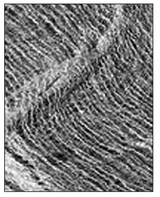
Cheesecloth.
Chintz: A lightweight cotton from India. It was famous for its beautiful flowery printed designs. It became very popular in Europe in the Eighteenth Century. It is often finished with a wax or starch glaze which is only temporary. Permanent resin glazes can be applied and these will stand regular washing. Chintz that isn’t glazed is called cretonne. Chintz gets its name from the Indian word, chint, meaning broad, gaudily printed fabric.
Classer: The person in the shearing shed who trims the fleeces and grades them into categories before baling.
Class-one Wool: The best quality fleece, usually produced by Merino sheep. The fleece has a fine, short, strong fibre with high elasticity and a strong crimp. It is a warm wool.
Class-two Wool: Not as good as Merino but still a superior fleece.
Class-three Wool: A coarse wool with fewer scales and not as much crimp as the other two classes of wool. Because they are smoother they have a more lustrous quality although they lack elasticity and strength. This wool is still able to be used for making clothes.
Class-four Wool: The least desirable of the classes of wool. The fleece is hair-like and coarse.
Classification by Fleece: Shows whether it is from lambs or older sheep, live or dead beasts.
Clean Content: The measurement of wool after it has been scoured and cleaned of all extraneous material.
Clean Wool: Wool after it has been scoured but sometimes refers to greasy wool that has had vegetable matter removed.
Clear Finishing: Is a process applied to worsted fabrics. The finished fabric is sheared, not brushed, to give it a smooth finish and crisp feel.
Clip: Amount of hair taken from a single angora goat.
Clock Reel: A device for winding hanks of yarn: some have counters to measure the number of winds.
Cloth: Another name for fabric.
Clothes Moth: In fact refers to the larvae of the moth that eats wool and other protein fibres. Moth balls made from naphthalene were a popular deterrent but tended to leave a strong odour. Sandalwood is also supposed to deter the moth.
Cloud Yarn: A term given to yarns of irregular twist obtained by alternately holding one of the component threads while the other, being delivered quickly, is twisted around it, and then reversing the position of the two threads; thus producing alternate clouds of the two colours.
Cloudy Wool: Discoloured wool often because it has been stored in damp conditions.
Coated Fleeces: Have you ever seen a sheep wearing a coat? Some farmers put coats on their sheep to keep the fleece from getting dirty and picking up plant matter.
Cockle: When a fabric has been shrunk the cockle is the wrinkle left where the shrinkage was inconsistent.
Colour and weave effect: Is the characteristic pattern made when different coloured warp and weft threads are used together in one piece of fabric.
Colour Matching: When a sample of dyed material is given from which to make a larger batch of dye and the proportions of pigments has to be managed to get the same hue.
Colour Fastness: The amount of colour retained by yarn or fabric after subjected to washing or exposure to sunlight.
Colour: The natural colour of the fleece. White and cream are preferable to coloured wools or those with canary stains or other discolouration.
Colour Defect: Anything that taints the white or cream fleeces such as canary stains, coloured wool mixed in with the white or any other form of discolouration.
Colour Fastness: That property of a dye to hold its colour even when put under certain stressful conditions, e.g., exposure sunlight, heat, immersion in water.
Combed fibres: Fibres that have been combed to remove the short fibres and straightening the longer ones so they lie parallel to each other.
Combing: The process of straightening carded fibres and to further remove impurities. As its name suggests combs are used. Combing can be done dry, that is without oil being added, or with oil so the fibres are easier to control.
Combing Wool: Wool that is long enough to comb.
Common: A US grade of wool, one up from the coarsest grade. It is supposed to have got its name from the common sheep from which it is shorn.
Complements: These are complementary colours that as found on a colour wheel. The primary colours are red, yellow and blue. When these are added to each other they make the secondary colours of: green (yellow and blue), purple (red and blue) and orange (red and yellow). When these have been added to the colour wheel their opposites are: yellow and purple, red and green and orange and blue. These are known as complementary colours.
Composition: The components and their amounts that make up a particular fabric.
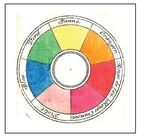
Colour wheel.
Condition: The moisture present in a textile fibre in its raw form. Also with regards to wool it is the amount of impurities it contains. A fleece said to have a heavy condition means it will shrink a lot.
Cone: Conical base onto which yarn is wound producing a cone.
Copp: Is the cone of fibres that build up on the spindle.
Corduroy: A fabric, traditionally made from wool which has a distinctive ribbed effect produced by weaving a cotton foundation in plain or twill weave with vertical cut-pile stripes, called wales.
Core-testing: The coring of bales or bags of wool to determine the clean content
Core Yarn: A yarn made by winding one yarn around another to give the appearance of a yarn made solely of the outer yarn.
Cortical Cells: The spindle shaped cells forming the inside structure of a fibre.
Cotted: A fleece that contains matted or felted fibres.
Cotton: A cellulose fibre from the boll of the cotton plant.
Cotton Damask: Fabric woven on a Jacquard loom using mercerised yarn.
Cotty Wool: Wool that has matted or felted on the sheep’s back. The problem is caused by an insufficient amount of oil being produced by the sheep.
Count: The number given to a yarn of any material, usually indicating the number of hanks per pound of that yarn. May also refer to the fineness to which a fleece may be spun.
Crabbing: Is a process of rotating the worsted fabric over cylinders through a hot-water bath, or series of baths, each hotter than the one before, followed by a coldwater bath.
Crease-Resistant: This refers to the ability of a fabric to resist and recover from creasing during use. Wool is considered to be very crease resistant, while cotton is not. And don’t even get me started on linen!
Creel: Is a storage rack for rolls of textiles
Crepe: A fabric with a distinctive, puckered surface due to different tensions used in the weaving process. Similar effects can be produced by using different types of yarn or applying chemicals.
Cretonne: Heavy ribbed fabric made from cotton.
Crewel Embroidery: Is an embroidery technique worked in wool and consists of an intricate design outlined and filled with a number of different stitches. The effect is rich. The origin of the word crewel possibly comes from an old word describing the curl in the fibre of the wool.
Crimp: Is the amount of waviness in wool fibre.
Crimp Recovery: A measurement for assessing how well a fibre returns to its natural crimped state after being pulled straight.
Crocking: The act of dye rubbing off fibres or fabric by friction.
Crinkle: The amount of waviness retained by a single fibre after it has been taken from a lock.
Crochet: A manner of making fabric using a stick with a hooked end. It is related to knitting but only uses the one implement and the loops are made by pulling the thread through itself and other stitches.
Crop: To remove loose fibres from the cloth’s surface after it has been woven.
Croop: The name of the sound made by silk when rubbed or compressed.
Cropping: The trimming of the pile of a fabric to make it even or the trimming of loose threads and fibres from a piece of finished weaving.
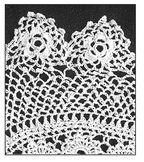
Crochet.
Crossbred or Cross Breed: Wool produced by interbreeding different species of sheep.
Cross colour: The use of different coloured warp and weft threads.
Cross-stitch: An embroidery stitch in which one stitch is laid down diagonally and another of the same length is laid across it, also diagonally to form a small cross. If has become a popular form of embroidery in which to make complex pictures, as subtle shading effects can be obtained.
Crutching: The shearing of a sheep’s rear end before the annual shearing of the whole fleece. This is to help prevent blowfly strike.
Crutched Wool: Wool that has been clipped from rear end and udder area of ewes in the early spring to prevent collection of manure and fly strike.
Cuticle: The outer layer of cells of a woollen fibre. They are hard and flat and overlap rather than fit snuggle together.
D
Dags: The fleece of a sheep’s rear end when matted with urine and faeces.
Damask: Has a reversible pattern woven into it. On one side the pattern is satiny and on the other side the ground has the lustre.
Damp Wool: Wool that has become damp or wet before or after storage.
Darn: The term used for making woven repairs in woollen products, typically socks. Traditionally a round wooden block is inserted into the sock to spread it while working on it. Small warp stitches are inserted across the hole and these are then woven across until the hole has disappeared.
Dead Wool: Wool taken from the carcass of a sheep that has died in the field or been killed. It is sometimes called ‘merrin’. It is an inferior grade of wool.
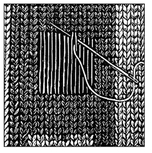
A darned hand-knitted sock.
Decatising: A mechanical process using steam for smoothing out fabrics, particularly wool. Fabric is placed around a roller with perforations in it from which steam issues through and around the fabric.
Defective Wool: Wool that contains excessive vegetable matter, such as burs, seeds, and straw, or which is kempy, cotty, tender, or otherwise faulty.
Degreasing: Any method that removes yolk, suint, and dirt from wool.
Degumming: The boiling-off of silk in silk and hot water, in order to dissolve and wash away the natural gum (seracin) which surrounds the fibre.
Delaine Wool: Fine combing fleece, originally from Ohio and Pennsylvania. The Delaine-Merino breed of sheep is a particular breed that produces this class of wool.
Demi-lustre Wool: A semi lustrous wool but not enough to be classed as lustre wool. Romney sheep grow this class of wool.
Denier: A unit of weight indicating the fineness of fibre filaments and yarns.
Denim: A basic cotton or blended fabric woven in twill with a strong, hard wearing surface. It is characteristically blue. It gets its name from the French term serge de Nimes.
Density: The number of wool fibres per unit of a sheep’s body. The finer classes of wool have denser measurements of fibre.
Devore: A technique for decorating fabric in which the pile of the fabric is burnt away with acid.
Differential Dyeing: Term for the same kind of fibres which may have different dyeing properties from the standard for that type.
Dimity: Is a plain weave cotton with a crosswise of lengthwise rib or crossbar effect. It is sheer with the ribbing effect slightly less so. It is crisp in texture and resembles lawn in its feel and look.
Dingy: Wool that is dark and tends to shrink heavily. May be caused by excessive yolk, poor farming conditions, or parasites.
Dipping: A chemical bath for sheep to reduce louse infestation
Direct Dyes: Aniline dyes which are good for dyeing cellulose fibres like cotton or flax. They do not need a mordant to fix them. They are characteristically duller than acid or basic dyes. They are very colourfast.
Direction of Twist: The twist is the natural direction the yarn wants to twist in. S typifies one way, Z the other. You can find out which ways a yarn will twist by holding it in a vertical position and looking closely at the angle of the spiral. The angle of the S twist will match up with to the centre part of the S. The angle of the Z twist will match up with the centre of the Z. When spinning, the wheel should rotate counter clockwise for an S twist and rotate clockwise for a Z twist.
Dirty Tips: The weathering that occurs on the ends of some locks. These may not completely wash out or take dye evenly.
Discolour: Fleece, yarn or fabric which has become stained through contact with something else, such as another dyed product, fading in the sun, water stain or anything else which has altered the intended colour.
Distaff: Wooden rod to which carded wool, flax or cotton is loosely wound. It is held under the arm or tucked into the belt and fibres drawn from it which are then fed into a spindle. The distaff was originally this hand-held one but as spinning wheels became generally used the distaff became attached to the machine leaving two hands free for guiding the thread.
Diz: This is a tool to help form an even top when combing wool. Diz were originally made of carved horn.
Dobby: A fabric woven on a dobby loom. Small, geometric figures are characteristic of dobby fabric.
Dobby: A mechanism that controls the heald shaft movement of a loom.
Doggy: Inferior fleece that lacks quality of distinctive breeds. These wools are usually short fibred and coarse.
Domestic Wools: All wools grown in your own country as opposed to those imported.
Doubling: The process of combing by twisting together two single yarns to form a double yarn.
Double Coated: Some breeds of sheep have two coats. Sometimes it refers to different colours; for instance a darker, longer coat over a shorter lighter coloured coat.
Double Cloth: A textile product made from two pieces of cloth woven together.
Double Drive: Both the flyer and bobbin are driven by belts from the drive wheel. The bobbin pulley (or whorl) is smaller, which determines the spinning ratio.
Double Fleece: A fleece consisting of two year’s growth.
Doupion or Doupioni: Term used for the phenomenon of double silk worm cocoons. It is also used to refer to the rougher quality of silk made from these cocoons. Because the filaments are tangled and sometimes broken they cannot be reeled off in the same manner as top quality silk and it has to be spun instead. Commonly found in shantung or pongee silk.
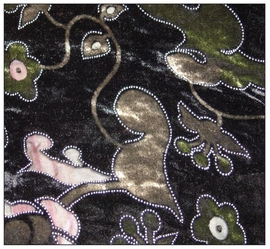
Sevore scarf.
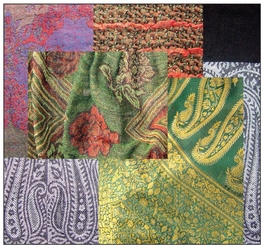
Fabric.
Down Wool: Also known as ‘Hill Wool’. The fleece of medium fine quality from breeds such as the Southdown and the Shropshire. They tend to have a fine and curly short staple particularly suitable for felting.
Drafting (or Drawing): A term used for the process of pulling fibres out of the carded bundle, usually attached to a distaff in order to feed them to the spinning device itself, such as a drop spindle or spinning wheel.
Paper patterns.
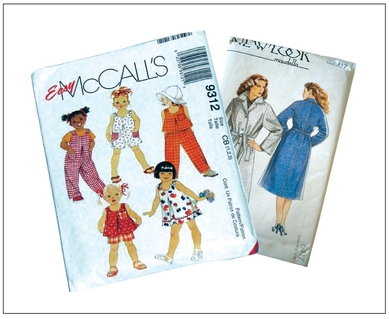
Drafting Triangle: Refers to the triangle made by the fibre being drawn from one hand and fed to the other, spinning hand. The height of the triangle should never be more than a length of the fibre being used.
Drape: This is the term to describe how a fabric hangs. Many factors affect the drape of a piece of cloth: the fibre it is made from, the weave, the dye and other finishes. Some fabrics have a naturally good drape others are too stiff,
Drenching: Squirting liquid worm medicine into a sheep’s mouth.
Drive Band: The cord that runs between the wheel and the flyer of a spinning machine.
Dress: Means a woman’s garment, the act of getting into one’s clothes, clothing in general, men’s or women’s. It can also refer to the finish on a piece of cloth.
Dressmaking: The art of turning fabric into clothing for women and children. Paper patterns became very popular so that anyone could make a fashionable outfit.
Drill: A cotton twill with closer, flatter wales than gabardine. It can be left a natural grey or dyed and bleached. When it is dyed khaki the fabric itself is then called by that name.
Drip-dry: The term for hanging a garment on the line or on a coat hanger to dry without other artificial means. Many newer man-made fabrics are drip dry so that they don’t require ironing or drying in an electric dryer.
Drive Ratio: Ratio of wheel diameter to flyer whorl diameter (or bobbin whorl on a bobbin lead wheel). Governs how much twist you get in the yarn for each treadle.
Drop Spindle: A spindle that hangs freely from the fibre.
Drum Carder: A rotating drum, covered with carding cloth, used to card fibres mechanically.
Dry clean: A purely chemical method of cleaning fabric. Used for clothing made from fabric not liking immersion in liquid because it is delicate or it is handmade, has much embroidery, bead or is tailored and might shrink in a bath.
Dry-Spun Flax: Flax spun without added water; results in a coarser, hairier yarn.
Duck: A fabric originally made of linen but now mainly in cotton. It has a plain weave and sometimes a crosswise rib. Its other name is canvas. It became known by the name ‘duck’ in the Eighteenth Century when British sails were given the trademark of a duck. It has a very firm weave and is used for all sorts of things from clothing to painting portraits on.
Duffle: Is a thick, heavy material made from wool. It takes its name from its place of origin, Duffel, in Belgium. We know it for the coats and bags named after the fabric they are made from.
Dull: A yarn or fibre with no lustre.
Dusting: The second step in commercial wool processing (after sorting). The purpose is to remove as much dirt and sand as is possible before scouring.
Dye: The source of colour to change the colour of yarn or fibre or cloth. Dye can be chemically made or got from natural sources such as plants.
Dye Activator: A pure alkali powder for use with all reactive dyes on cotton and cellulose fibres.
Dyeability: The capacity of fibres to accept dyes.
Dye bath: The solution (usually water) containing the dyes, dyeing assistants and any other ingredients necessary for dyeing.
Dyed in the Wool: Fleece or spun yarn dyed before it is processed.
Dyeing: The process of applying a dye colouring to fibre, yarn or fabric.
E
Earmark: Marking a sheep’s ear for identity purposes.
Eastern Pulled Wool: Wool is pulled from the skins after it has been loosened, usually by a depilatory. Pulled wool should not be confused with dead wool.
Ecru: The natural colour state of a fabric before it is exposed to the colouring processes.
Elasticity: The ability to return to its original length after being stretched or compressed. Wool has more elasticity than cotton.
Elastomer: Is a man-made rubber-like textile that can stretch three times its own length. After stretching it will return to its original shape.
End: A warp yarn.
English Combs: Hand combs used in preparing top.
Evenness: This term refers to the uniformity of the fibre throughout the fleece.
Ewe: Female sheep
Exhaustion: The amount of dye absorbed by the fibre, yarn or fabric from the dye bath.
F
Fabric: Any cloth woven, knitted or made using other processes from fibres.
Face: The finished, visible side of a piece of fabric.
Fall Wool: American term for fleece shorn in the autumn.
Fast Colour: A dye that is very good at retaining its hue in conditions like harsh sunlight.
Fellmongering: The process of gathering wool from the fleeces of dead sheep.
Felt or Felting: Non-woven fabric made by layering thin sheets of carded wool fibres, then applying heat, moisture and pressure to shrink and compress the fibres into a thick matted cloth. Not the same as fulling which is the shrinking of a pre woven or knitted fabric subjected to a similar process to felting. The finished pieces look very much the same.
Feltability or Felting Property: The ability for certain fibres to interlock in the felting process.
Fibre: The basic raw materials in textiles which can be natural or man-made, such as wool, silk, cotton, flax or nylon.
Fibre Fineness: The diameter of a fibre usually measured in microns.
Fibre Length: The staple length of the fibre. On combing wools, this is often 3 – 8 inches, on the down wools 1.5 – 3 inches. With cotton, it may be ¼ – 1 inch long. Bast fibres, likes flax, may have a staple length of 36 inches.
Fibre Thickness: The average diameter of the fibre usually measured in microns.
Filament: A fibre of indefinite or extreme length, some of them miles long. Cultivated silk is a natural filament, while nylon and polyester are synthetic filaments though they originated when imitation silk was begin invented. Filament fibres are generally made into yarn without the spinning operation required of shorter fibres, such as wool and cotton. Filament yarns are smoother and more lustrous than spun yarns.
Fine Wool: The finest grade of wool.
Finishing: Any further process applied to fabric after it has been woven and removed from the loom. It can even mean anything that is done to a fabric after it has been dyed or decorated in some way. Sometimes chemical or other applications are applied to the fabric to make it stiff or shiny. In some cases these need to be removed before the product can be used.
Flame Retardant: Is both the measure of a fabric’s ability to withstand heat and flame or an additive that will increase that resistance.
Flammability: The ability of a textile to burn under specified test conditions.
Flannel: A woollen fabric of plain or twill weave, made of wool worsted, cotton or rayon, which originated in Wales. It has a dull finish with a soft napped surface. It must be pre shrunk or washed before making into garments as it will shrink.
Flannelette: A cotton fabric woven in plain or twill and finished with a nap, usually on one side only. It is often used for making sleepwear.
Flax: The plant whose long stalk provides the source of bast fibres for spinning linen thread.
Fleece: The wool from one sheep, either as it comes from the animal or after it is rolled into a bundle and tied. Is also the name given to a fabric made of wool, cotton and some specialty fibres. It has a deep soft nap and is a thick, bulky material. Used mainly for making coats.
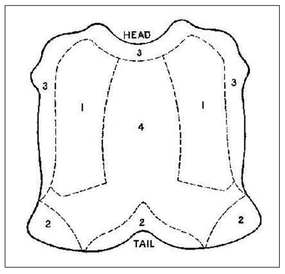
Fleece.
Fleece rot: An infection on the sheep’s skin caused by a lot of wet weather.
Float: A length of yarn on the surface of a fabric between adjacent intersections of warp and weft threads.
Flock: Is the collective noun for a group of sheep. It is also the name given to unspun wool or cotton that is used for stuffing things like pillows.
Footrot: a disease in sheep that affects their feet and ability to walk.
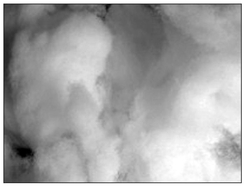
Flock.
Flyer: A rotating device that adds twist to the slubbing or roving and winds the stock onto a spindle or bobbin in a uniform manner.
Flyer Bearings: Holds the flyer it is made from the same material as used in wheel bearings
Folded Yarns: Another term for plied yarns.
Flyer Lead: A single band drives the flyer. The bobbin has an adjustable friction band to slow it.
Follicle: The skin structure from which hair or wool fibre grows.
Footman: The vertical connection between the treadle and the crank.
Frame Spinning: The manufacture of yarn by easing a sliver of fibre by means of rollers and then inserting twist by means of a flyer, a ring and traveller, or a cap.
Frame Wheel: The flyer is usually mounted above the wheel so that it takes up less room. Also called a ‘castle wheel’.
Free Wools: Usually means wool that is free from defects, such as vegetable matter.
French Combing Wool: Wools that are medium length between strictly combing and clothing. French combs can handle fine wools. French combing is done dry.
Fribby Wool: Wool containing an excessive amount of second cuts and / or sweat locks.
Frowzy Wool: A harsh wool, lacking in character.
Fugitive Colours: Dyes that fade especially in sunlight or through washing.
Fulling: The operation of shrinking and felting wool that has already been made into fabric.
Fulling Agent: A chemical, usually a surfactant, that acts as a lubricant during the process of fulling.
Fustian: Is an old fabric that was very popular in the Middle Ages and up to the Seventeenth Century. It is a mix of wool and linen or cotton and linen. It gets its name from Fustat near Cairo in Egypt.
G
Gabardine: Is a fabric made of worsted cotton, rayon or mixtures of these. It has a twill weave and is tightly woven. It is hard wearing. Used mainly for men and women’s suits and coats.
Gingham: Plain weave lightweight cotton with a distinctive check pattern. It derives its name from the Italian expression ging-gang meaning striped.
Ginning: Is the mechanical process that removes the cotton fibres from the seed. The cotton gin was invented by Eli Whitney toward the end of the Eighteenth Century.
Glauber’s Salt: Sodium sulfate. An acid used in dyeing to help protein fibres take colours evenly.
Grade: Is the term given to the size of knitting needles used for knitting a garment. The larger the number of the gauge the smaller in diameter the needle is and therefore this will make the knitting itself finer. And the reverse is true too. The smaller the gauge the larger the needle and the chunkier the knitting.
Grading: Is a term used for classifying fleeces according to their qualities in fineness, length of staple and whiteness.
Grey Wool: Is the term given to fleece that is not pure white but contains some fibres of a darker colour which happens more often with sheep that have black faces.
Greasy Wool: Unwashed, unprocessed sheep’s wool complete with the natural lanolin produced by the sheep.
Great Wheel or Walking Wheel: An early form of hand turned spinning wheel. The spinner would turn the wheel with one hand while drawing out the carded wool with the other. The spinner would then walk away from the wheel while the yarn twisted into thread. It would then need to be wound onto the spindle and the process started again. It is estimated that a woman spinning eight hours a day could walk 20 miles just using the Great Wheel.
Grist: A measurement of yards per pound of weight. Grist is synonymous with ‘count’.
Guanaco: A woollen fibre from the Guanaco, a relative of the llama.
Guar Gum: Is an industrial strength gum used to thicken the paste used for burning out the fabric design in devore.
Guard Hair: Is the wool which sticks out from the undercoat of an animal. It is typically coarse and hair like.
Gummy Wool: Wool that has been scoured but retains some of the yolk in it.
Gutta: Is the French word for ‘resist’ and it is a form of resist dyeing using a water or solvent soluble gum or resin to create the pattern on the fabric. Similar in function to wax in batik.
H
Hessian: Is the German name for a coarsely woven fabric, usually made from jute fibre. It is also known as burlap. It is mainly used to make sacks for storing things like potatoes. It is not often used as a clothing material. A hessian like textile was used to make a sackcloth or hair shirt.
Habick: A device used in Medieval times to hold fabric under tension during its final preparation and dressing. It is related to the frame used
Hackles: The comb for preparing flax or hemp fibre by removing any bits of outer stem.
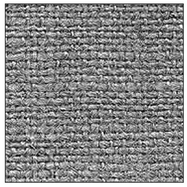
Hessian.
Hackling: The process of removing any extraneous material from flax or fibre after it has been retted. The flax is pulled through a comb called a hackles, sometimes there is a series of hackles getting progressively finer.
Hair Fibres: Wool-like fibres from animals other than sheep, including the alpaca, llama, vicuna, cashmere goat, angora goat, angora rabbit and Bactrian camel.
Hand or Handle: Term used for how the wool feels to touch whether it is soft, coarse, fine, long is springy or straight.
Hand-washed Wool: Wool washed on the animal before it is shorn from the sheep. Really has to be done by hand.
Handspun: Yarns which are spun by hand using a spindle or spinning wheel.
Hank: A measurement of yarn which, for some fibres is a specific amount.
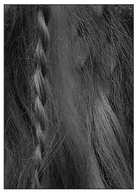
Human hair.
Hard Twist: A yarn with increased twist.
Harsh: A coarse, rough wool.
Harris Tweed: Is a tweed fabric hand woven in the islands off the North coast of Scotland. Harris Tweed comes in two types: that made from hand-spun yarn and that made form machine-spun yarn. Because it is handmade it is very time consuming to make and is very expensive.
Heald: A small device made from steel, wire or even cord with an eye through which a warp thread can be inserted.
Heald Shaft: A weaving frame that has healds in place
Heavy Wool: Wool that still has a lot of grease or dirt in it and therefore will shrink a lot during scouring.
Hemp: The fibre from the plant Cannabis sativa.
Herringbone: A combination of twill weaves in which the direction of twill is reversed to produce stripes resembling herring bones.
Herringbone Stitch: Is an embroidery stitch that imitates a herringbone pattern.
Herringbone Twill: A type of twill weave made up of vertical stripes alternately right hand and left hand in direction, giving it a herringbone look.
Hogget Wool: Hogget is a sheep that is 12 to 14 months old and has never been shorn. It is more mature than lamb’s wool but is still fine and soft and strong.
Homespun: Named for the fact that this fabric was originally produced in the home for the use of its occupants. It was generally a coarser yarn making a coarser cloth that is tough.
Houndstooth: Describes the check pattern more than the fibre it is woven from. It is a distinctive check pattern where the checks are not square but more star shaped.
Hue: The colours that appear in the spectrum: red, orange, yellow, blue, green violet. It is also used to describe colours that tend towards one of those colours.
Hungry Fine: Is a fine wool fibre that has been caused by poor nourishment.
I
Ikat: Resistance dying method in which the warp and/or weft threads are dyed before they are woven in order to produce a decorative pattern.
Impurity: Any extraneous material present in a fleece or textile product such as seed heads or twigs.
Inchworm: A name given to spinners who are too slow and careful about drawing out and spinning their fibres due to lack of inexperience. Such methods halt the flow of spinning and the production of consistently smooth yarn.
Indigo: A blue dye obtained from plants of the Indigofera family. It is used as a vat dye and must ferment for a certain time to be of any depth of colour.
ISO: International Standards Organisation is an international body which looks out for the quality of goods.
J
Jacquard: An invention from the late Eighteenth Century to enable weavers to lift several warp threads at a time in order to produce complex patterns in the fabric. It was invented by Joseph Jacquard in France.
Jersey: Is a knitted fabric made of a number of different fibres. It has lengthwise ribs on the right side of the fabric and cross wise on the back. It is stretchy and crease resistant. Named after the island of Jersey where it was invented.
Jute: A vegetable bast fibre often used for basketry, rope and coarse fabric used to make sacks.
K
Kapok: A vegetable seed fibre from the kapok tree.
Kemp: A type of wool fibre that doesn’t function as normal wool fibre does. It won’t felt or take dye and is very coarse in texture. It is often found around the head and legs of the sheep.
Keratin: A protein substance which is the chief component of wool fibre.
Khadi: A type of Indian cotton that is spun and woven by hand. Gandhi advocated the weaving of it to make clothes for the Indian people so they could shun British made goods.
Knitting: A process for making fabric involving two needles that loop the yarn over previously made loops.
Knop: A group of fibres appearing along the length of yarn, giving a textured effect.
L
Lace: A textile that has an open, net like structure, used for decoration on garments. It can be made by knotting, knitting, crochet, needle and thread, tatting or with bobbins.
Lambwool: Wool from lambs before they are 7 – 8 months old. It is a soft fibre and is better for spinning than wool from older sheep.
Lanolin: The natural oil from a sheep’s wool.
Latex: Is a natural material that has a milky colouring and texture. It is used to make a variety of textiles
Lawn: A plain weave cotton that takes its name from a city in France, Laon, where it was made. It is lightweight, soft and can be dyed, left plain or printed. Used for making dresses, shirts, curtains, children’s wear and handkerchiefs.
Lazy Kate: A device for holding bobbins ready for plying. Traditionally made to look like a ladder.
Lea: A measurement for linen yarn in length to weight.
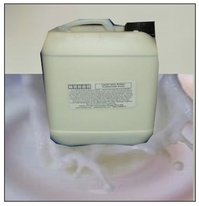
Jar of liquid latex.
Leader: This is yarn attached to the bobbin or shank of a spindle to help when starting spinning a length of yarn.
Lehariya: Indian tie dyeing method.
Level: A dye term referring to even colour. This will only happen in some cases with the use of an additive.
Light Fastness: Resistance to the fading effect of light or sunshine.
Line Fleece: A fleece which can be thrown into one grade or another because its quality lies between the two.
Line Flax: Line fax is the long fibre that will be spun differently to tow, the shorter fibre.
Linen: Fabric made from flax or hemp. It is one of the oldest fabrics produced by mankind.
Llama: An animal of the camelid family and is native to South America. It is a relative of the Alpaca. The fibre is lustrous and light weight.
Lock: A tuft or group of wool fibres that cling naturally together in the fleece.
Loden cloth: A fabric originally made from wool but now made from wool mixes such as mohair or camel. It is thick, warm and durable with a water resistance.
Lofty Wool: Wool that is open, springy, and bulky in comparison to its weight. This type of wool is desirable.
Loom: A machine for producing cloth by the interlacing of two sets of threads substantially at right angles to each other.
Loom State: What a piece of woven fabric is called just as it leaves the loom and before it undergoes any other process.
Long Wool: Fleece from breeds like the Lincoln, Leicester, and Cotswold. Each fibre is thick and very long.
Lowland Wool: A fleece that is often coarser than most and has either ashorter, curlier fibre or a longer straight one; often used in worsted fabrics.
Lurex: A modern textile consisting of a metallic thread given a plastic outer layer to make it shiny.
Lustre: The natural gloss or sheen of a fibre, usually of long-wool breeds.
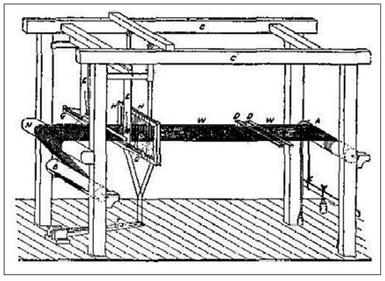
Loom.
Lye: Sodium hydroxide. Strong alkali used with vat dyes such as Indigo. Always add Lye to cold water not warm!
M
Mackinaw: Wool fabric composed of ordinary grade wool and recycled or low grade wool blended with it. It is often fulled or felted. It is also known as ski cloth and snow cloth because of its thick, heavy weight that makes it a natural choice for outdoor winter pursuits.
Madder: The root of the Rubia tinctorum plant and used as a natural dye for thousands of years. It can produce hues ranging from reddish brown, deep red to purple.
Madras: Cloth originally made in Madras, India, hence its name. It is usually made from cotton and is often a plain coloured background with stripes or checks.
Magnanery: Shed for housing silk worms.
Maiden: The name for the posts that support the flyer on a spinning wheel. Maiden, and the base that supports them, is called the mother-of-all.
Man-Made Fibre: A man-made fibre is one that has been manufactured using chemical processes and additives even if the base for the fibre is something natural like cellulose. The fibres, broken down into a liquid state by acids, are then pushed through a spinneret to simulate the thread of a silkworm or spider, after which more processing may take place.
Market Class: The class into which animals are put for their end product: meat or wool.
Marl Yarn: A yarn consisting of two or more single ends of different colours plyed together.
Martindale: An abrasion test used to measure the durability of fabric. The warp and weft threads are abraded simultaneously.
Mawata: Silk cocoons that have been heated in lightly boiled in water put out on wooden frame.
Mercerisation: A process of treating fabric with caustic alkali so they swell and stretch in order to increase the lustre.
Medulla: The core of a single wool fibre.
Mercerizing: The process of soaking fabric in a cold, concentrated solution of sodium so that the fabric will have a lustrous finish. It was invented by John Mercer.
Metamerism: The effect of light on the appearance of colour in fabric.
Micron: A measurement used in grading wool.
Milling: A fulling process by immersion in water and agitating it to make it shrink and thicken up. Called after the mills where it was made. Fulling mills were the first water-driven machines used in processing textiles. They were being used in medieval times and earlier.
Modacrylic: This is fire, chemical and abrasion resistant yet is a soft man-made textile.
Mohair: the hair of the Angora goat. The fibres are long, lustrous and silky it is also stronger and more resilient than wool. It accepts dye more easily than many other hair fibres.
Moity Wool: Wool that contains straw or other, non-seed-or-burr vegetable matter.
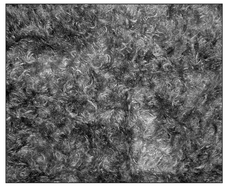
Mohair yarn.
Mordant: A material used to fix a dye in or on a substance, by combining with a dye to form an insoluble compound. Commonly used mordants are chrome, iron, aluminium, and tin.
Mother-of-all: The whole stand that supports the maidens, bobbin, and flyer.
Mulesing: The removal of the wrinkled skin around a lamb’s rear-end so that no wool will grow there.
Mungo: Wool fibres recovered from old and new hard worsteds and woollens of firm structure. The fibres are less than .5 in. in length, and owing to their reduced spinning and felting qualities, they are largely used in cheaper woollen blends. Mungo fibres are usually shorter than shoddy fibres.
Mushy Wool: Wool that is lacking in character and is often dry.
N
Nap: A pile raised on the fabric by brushing it. The appearance of the fabric is altered by the way the nap catches the light. It is important to take the nap into consideration when dressmaking.
Napping: The process of raising fibres from the base structure of a fabric or felt by brushing.
Natural Dye: Dye obtained from substances such as roots, bark, wood, berries, lichens, insects, shellfish and flowers.
Natural Fibre: Fibre obtained straight from the source whether that is: animal, vegetable or mineral sources. Regenerated and synthesised fibres are not natural fibres.
Navajo Ply: A hand-crocheted loop used to create a three-ply yarn.
Neps: Small knots of tangled fibre, usually consisting of short, dead or immature fibre, or caused by over-processing and not the result of deliberate planning.
Nettle Fibres: Fibre obtained from nettles such as Ramie in China. These are bast fibres.
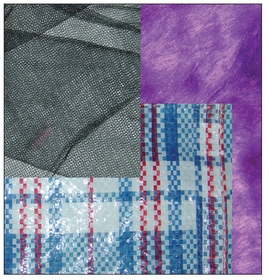
Man-made fibres.
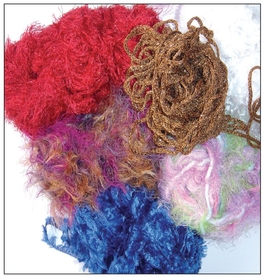
Novelty yarns.
Noils: These are the short fibres taken from the wool when it is being combed. Noils are used for spinning and felting.
Novelty Yarns: Yarns with a quirky appearance that may well have a short fashion run. Often they are made from artificial fibres.
Numerical Count System: A wool grading system. It divides all wools into 14 grades, and each grade is given a number.
Nylon: The generic term for man-made fibres composed of polyamides derived from coal and petroleum. Characteristics: high strength, elasticity, low water absorption and quick-drying, resistant to insect attack, abrasion and resistant to some dyes. It is used for making everything from pantyhose to fishing lines and rope.
O
Olefin Fibre: A man-made fibre that is very strong despite its light weight. It will resist mildew, staining, abrasion and chemicals. It is used to make clothing and many of the interior components of cars.
Organdy: A fine cotton fabric made with slightly twisted yarn. Typically sold with a crisp finish which is deceptive because it is the result of a starch that will wash out.
Organzine: Silk thread that has been thrown, doubled and twisted to make a four-ply yarn.
Off-sorts: The by-products of sorting wool. Off-sorts includes: short fibres, britch wool, kemp, grey wool and stained wool.
Open Wool: Wool tends to grow sparsely on a sheep and shows a distinct part down the ridge or middle of the back. Usually found in the coarser wool breeds.
Opening: The term given to the second step in commercial wool processing after sorting. The fleece is thrown flat so that scouring will be more efficient.
Overlocking: The joining of two pieces of fabric by double stitching over and around the edges. Overlocking machines are very popular and give a professional finish to seams.
Oxford: A cotton fabric with a basket weave look. It is popular for making men’s shirts.
P
Patchwork: A new fabric made out of smaller pieces cut from other fabrics and stitched together to form a design. It was a way of using up scraps and material from clothing that had worn out or was too small.
Pick: A weft thread passing through a warp thread.
Piece Dyeing: Fabric that is dyed after it is woven.
Pelt: The skin from a slaughtered sheep before the wool on it has been pulled or processed into a sheepskin.
Pilling: Small balls of fibre that develop on the fabric due to general wear and tear. It is common in knitwear made from cheap yarn.
Pina: The vegetable leaf fibre from the pineapple plant.
Pieces: The skirtings and other less-desirable pieces of wool removed from the fleece (an Australian term).
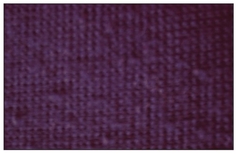
Pilling.
Plain Wool: Wool lacking character and with few crimps.
Plant Fibre: A textile fibre taken from a plant, e.g., cotton, flax.
Plied Yarns: Yarns produced by two or more single ply yarns being twisted together.
Ply: A single thread of yarn. If two or more of these are twisted together then they will form a multiple ply.
Plying: The process of taking multiple singles and twisting them back against themselves.
Polishing: A process involving burnishing a plied yarn to give it a sheen.
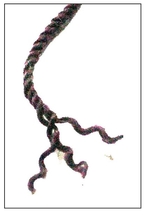
Plyed yarn.
Polyester: A manufactured fibre made from long-chain synthetic polymers. Characteristics: crease-resistance, quick-drying, great shape retention, high strength, abrasion resistance and easy care. Its original shape is determined by heat and will not be damaged with exposure to sunlight.
Poplin: A fabric similar to broadcloth but with a more pronounced filling. It is usually mercerized. If it is intended for outdoor use it is coated in a water repellent finish.
Pot Ash: Potassium Carbonate. A natural mordant for dye.
Presser: The person who puts the sorted wool of the shearing shed into a mechanical press to be made into bales.
Primitive: A fleece that contains long and short fibres.
Printing: A form of surface decoration applied to fabric by applying thickened dye to a plate carrying a carved or engraved motif that is to be transferred to the fabric.
Production Sequence: With regards to wool: Shearing, sorting, opening, cleaning, carding, drawing, possibly combing, possibly roving, twisting or spinning.
Protein Fibre: A fibre composed of protein, including such naturally occurring animal fibres as wool, silk, alpaca, llama and other hair and fur fibres.
Pulled Wool: Wool pulled from the carcass of a slaughtered sheep after the flesh side has been treated depilatory.
Purity: Refers to the absence of dark fibres, kemp or hair.
Q
Qiviut: Downy undercoat fibre from the musk ox.
Quality: Refers to the degree of fineness in wool fibre and fabric.
R
Rafia: A fibre taken from the rafia palm.
Ramie: A species of nettle that has bast fibres used for making cloth.
Range Wool: Wool produced under range conditions in the West or the Southwest. With the exception of Texas and California wools, it is usually classified as territory wool.
Raw Silk: Silk reeled straight off the cocoon and without degumming so it retains its stickiness.
Raw Wool: Another name for greasy wool.
Rayon: A generic term for man-made fibres composed of regenerated cellulose derived from trees, cotton and woody plants. It has good drape-ability, is highly absorbent, can have a bright lustre or a dull one and takes dye readily. It is also very strong and resistant to household bleaches and other chemicals.
Reclaimed Wool: Wool that is reclaimed from new or old fabrics.
Reed: Comb-like feature of a loom through which the warp-end pass.
Reeled Silk: A long strand of silk reeled from a number of cocoons and not twisted or spun. In order for this silk to be harvested the pupa in the cocoon has to be killed first with heat.
Regain: The weight of moisture present in a textile fabric expressed as a percentage of the oven dry weight.
Regenerated Fibres: These are man-made fibres that have natural fibre bases. Rayon and acetate are two common types. Rayon is made from wood chips and acetate from cotton. Both are modified by immersion in an acid type bath.
Rejects Fibres: Those not good enough for processing further with the quality fibres. For example: in fleeces, those with excessive coloured fibres and alien matter (twigs, dirt, burrs etc.).
Reprocessed Wool: Scraps and clips of woven and felted fabrics made of previously used wool. These remnants are garnetted; that is, shredded back into a fibrous state and used in the manufacture of woollens (spun like short fibre fleece).
Resilience: The power of recovery to original shape and size after removal of the strain which caused the deformation. A fibre may possess this quality to spring back to its original state after being crushed or wrinkled. Resilience is sometimes referred to as memory.
Retayne: A cationic dye fixing agent. Used on cotton fabrics to improve wet fastness of direct dyes and to colour paper pulp. Is helpful as an after treatment for reactive dyes where washing facilities are not adequate for complete washout, though tends to lower light fastness qualities.
Retting: This is the process in flax production that weakens the fibres in the flax plant. Several retting methods are used:
Dew or Grass Retting. Small bundles of the uprooted flax plants are left outdoors for 3 – 5 weeks.
Pond Retting. Small bundles are left submerged for 4 – 8 days. Many books refer to an unpleasant stench as a side effect of this process.
Stream Retting. Small bundles are anchored in a body of moving water. This is the quickest and the cleanest of the processes.
Reused Wool: Wool that has been made into fabric, used and worn out, the less desirable parts of a fleece and fleece that is not good quality can all go into the shredder for processing to be re-spun or felted. Wool can be recycled at home in many other ways too:
Cut up old jumpers and full the pieces for different projects – bags, toys, wall hangings
Unravel garments that are too small or out of date, wind the yarn into balls and knit into something else.
Cut up old garments of any fabric and use the fibres to make punch rugs or latch hook rugs in an age old tradition.
Rippler: The name of the coarse comb used for removing seeds from flax fibre.
Rippling: The process in flax production that removes the seeds. The seeds are removed before retting takes place, that is the breaking down through soaking in water of the outer casing of the plant stem.
Robust Wool: Strong wool with plenty of bulk.
Rolag: A roll of carded fibre that is rolled from the hand carders. It is light, soft and fluffy, looks a bit like candy flow. It is then ready for spinning.
Rooed: Shetland sheep are not shorn. Their fleece is plucked from them by hand. Rooing is the name of the process. The sheep’s fleece will naturally start to loosen at a particular time of the year.
Rouseabout: The Australian term for the person in the shearing shed who gathers up the fleece from the floor and keeps the place tidy.
Roving: Fleece after is has been cleaned and carded ready for spinning.
Rug Making: Rugs have been made for centuries and many different methods have been used. Felt was an early type and weaving. Later there have been hooked rugs where the wool is cut into short lengths and hooked through holes in an open weave canvas and pulled through the loop it has made so that it remains knotted in place. Punch rugs became popular as a way of using old, worn out clothing and sacking as the back. A punch tool was used to push the strips of fabric through the loose hessian weave. The pile on the other side could be left looped or it could be cut. Plaiting strips of material and then stitching them in a coil has also been popular for thrifty homes.
S
S-Twist: Spinning clockwise. Traditionally, this is the direction single plies are spun.
Sackcloth: Originally a coarsely woven fabric made from goat’s hair but then associated with hemp. It later came to mean an item of clothing worn by the Israelites during the mourning period. It was also symbolic of submission and was worn by prophets. Later again to wear sackcloth was a type of penitence and was known as a hair shirt and worn on Ash Wednesday.
Sailcloth: Takes its name from one of the popular products made from it. Sailcloth is a heavy weight canvas or duck.
Sateen: A cotton or rayon fabric with a sateen weave that is lustrous. It can be given a mercerized finish for extra sheen.
Satin: A very lustrous fabric that can be quite heavy, draping well. It can be made of silk. It is a luxury fabric and used for glamour wear.
Saxony Wheel: The spinning wheel featuring a treadle for the foot that came into favour in the Sixteenth Century and replaced the hand turned Great wheel.
Scotchguard: The brand name of a chemical compound that is used to finish fabrics that will come into contact with dirt, water etc. Upholstery is often treated to a layer of scotchguard.
Scouring: the process of washing a fleece to remove any excess oil and dirt. A fleece can lose 50 per cent of its original weight after scouring.
Scroop: The rustling sound produced when some silk is compressed.
Scrutching: After flax has been retted the softened outer stem is ready for scrutching which entails beating and breaking the outer fibres so that the inner bast fibres can be separated from the other.
Sea Island Cotton: A type of cotton. Its white silky texture gives it the title of the world’s finest cotton. It was for a long time grown in the Carolinas and Georgia but is now grown in Mexico and Central America.
Seersucker: A cotton or rayon fabric with a crinkled texture produced by using slack and taut yarns in the warp. The name derives from a Persian word shirushaker which means milk and sugar. While the texture is traditionally woven in there are now seersuckers produced by other methods including chemicals and heat, these last two are not necessarily permanent.
Selvedge: The edge of a woven fabric where the weft turns back on itself to be woven across the warp again. Selvedge edges cannot fray.
Semi-bright Wool: Grease wool that lacks brightness due to the environment under which it is produced, though it is white after scouring.
Semi-worsted Yarn: Yarn spun from sliver carded (not combed) and pin-drafted on worsted spinning system machines.
Sequin: Small flat bead made of metal (or plastic) with a single hole in the middle to be sewn onto fabric for decoration; they are usually shiny.
Sericin: The glue like substance binding silk filaments together so they form a cocoon.
Sericulture: The art and craft of raising silk worms, harvesting the silk and preparing it for spinning and weaving.
Serge: A wool based fabric made in a distinctive twill weave. A diagonal appears in the weave running from the lower left corner of a piece of fabric to the upper right corner. It is hard wearing and has a hard, smooth finish which will go shiny with wear. Traditionally is made into suits and coats.
Serrations: The outer or epidermal scaly edges on the wool fibre which can be seen under a microscope: usually the finer the wool the greater the number of serrations. Serrations assist in felting by interlocking.
Sett: A term used to define the weft or warp density of a woven fabric, usually in terms of a number of threads per inch.
Setting the Twist: After you have plyed your wool, you need to set the twist. There are several approaches to this. One school of thought says that you wash your yarn and then dry it under tension. This approach is fairly popular with weavers. Another approach says that you wash your yarn and don’t dry it under tension. This approach is more popular with knitters. Yet another approach, promoted by Judith MacKenzie, says, really shock your wool and let it do what it’s going to do. This is done by washing in alternating hot and cold baths. A more detailed description is written up by Marie-Christine Mahe in Yarn Abuse.
Shafty Wool: Wool of extra good length, sound, and well grown.
Sharkskin: Not literally. It is instead made of wool and is worsted. The weave has distinctive diagonal lines running across it that gives a ‘step’ effect. It is very smooth to the touch and is used mainly for suits.
Shatush: This is an unusual fabric made from the hair of wild goats and is usually white, silver or grey. It is very fine in its texture and is one of the rarest fabrics in the world.
Shearing: The process of removing the fleece of wool from the sheep by means of hand shears or machine clippers.
Shed: The gap formed when warp threads are separated during the weaving action.
Sheepskin: The wool of the sheep still on the pelt or skin.
Shetland: Fleece from the sheep of the Shetland Islands in Scotland. The wool is not shorn from the sheep but plucked from it by hand. It gives three grades of wool: coarse from the outer coat, fine from the undercoat and superfine from the belly area. It is often left in its natural colourings of off whites, greys and browns. It is rarely dyed.
Shifu: Thread made from paper is an old Japanese tradition and has been used historically in clothing.
Shoddy: Wool fibres that are recovered from either new or used woven or felted cloth and which must be designated as reprocessed or reused. Wool fibres included in this classification usually run 0.5 inches or more in length, they are of longer fibre length than mungo fibres.
Shorts: Short pieces or locks of fibre that are dropped out while fibres are being sorted.
Shrinkage: The loss of weight in wool resulting from the removal of the yolk and other foreign matter in scouring or carbonisation.
Shuttle: The mechanism on a loom that carries the weft thread through the shed to interlace with the warp.
Silk: The product of the silkworm when it spins its cocoon in which it will pupate then turn into an adult moth. The most common cultivated moth is bombyx mori and was first domesticated in China. In order to harvest the long unbroken filament of the cocoon it must be thrown into hot water to kill the moth before it hatches. Once the cocoon is broken the thread will have to be spun like wool and the silk is felt to be less fine.
Singles: A single ply of yarn.
Sirospun: The term for spinning and twisting two strands together in a single operation to create a two ply yarn. The resulting yarn is more elastic, less hairy and is firmer than normal two-ply yarns.
Sisal: A vegetable fibre that is made into strong, coarse twine. It has been used for other textile products.
Size: Any of various gelatinous or glutinous preparations made form glue, starch, etc., used for coating the threads and yarn.
Sizing: Applying a size to fabric or yarn.
Skein: A length of yarn taken from the reel, wound into a long bundle, not a ball, and tied at one or more points to prevent tangling.
Skeining: The processing of winding a skein of yarn. This process can be done with a small frame-like structure.
Skew: What results in weaving when the warp and wefts are not at complete right angles to each other.
Skirting: Trimming all the dirty and less desirable parts of a fleece before shearing the whole.
Skirtings: The inferior quality wool that has been removed from the fleece.
Slippage: Unintentional shifting of warp or weft threads in weaving resulting in gaps in the fabric.
Sliver: A strand of loose fibres after carding.
Slub Yarns: A yarn which is deliberately made with slubs or bumps in it to create texture.
Snarls: Small, curly or knotted sections of yarn.
Soda Ash: Sodium Carbonate. Use as an alkali fixative for reactive dyes.
Sodium Acetate or Sodium Acetate Crystals: An acid-forming salt that acts as a levelling agent for Sabraset/Lanaset dyes.
Sodium Bicarbonate: Bicarbonate of soda or baking soda. An alkali used to set reactive dyes by steaming or ironing.
Sorting: The process of separating a fleece into its various qualities according to diameter, length, colour ,strength and cleanness.
Soutache: Decorative braid, woven or crocheted.
Space-Dyed: A yarn or fibre that has been dyed at irregular intervals.
Spandex: A textile that can stretch five times its own length and go back to its original shape. It is lightweight and is used mainly for sportswear and foundation garments (corsetry).
Spindle: An ancient device for making yarn. At its most basic level it can be just a stick. The spinning is more efficient if a weight is added to the bottom of the stick, this is called a spindle whorl.
Spindle Spun: A yarn produced on a hand spindle.
Spinner’s Type: A fleece that is good for spinning without too much cleaning and preparation.
Spinning: The drawing out and twisting of fibres to produce a yarn.
Spinning Jenny: An early spinning machine having more than one spindle, enabling the spinning of several threads at once.
Spinning Wheel: A device used for spinning fibre into yarn or thread, consisting essentially of a single spindle driven by a large wheel or a flyer driven by a treadle.
Spinster: Originally meant a female who spun thread. It was not used in England with its unflattering modern connotations until the Eighteenth or Nineteenth Century.
Spun Silk: A yarn composed of fibres of silk which have not been reeled from the cocoon but have been gathered from wild cocoons or are cultivated cocoons that have been damaged. The silk fibres are short, not the long unbroken filaments of cultivated silk and need to be spun in a manner similar to wool.
Stained Wool: Discoloured fleece which will not scour clean.
Staple: A cluster or group of wool fibres naturally clinging together in the fleece.
Staple Length: The sample fibre length from a fleece.
Staple Length: The length of sheared locks measured as it comes straight off the animal and without stretching or disturbing the crimp.
Stenter/Tenter: A finishing machine used for drying and to set fabric width.
Stock Dyeing: Dyeing of the whole fleece. Most stock-dyed wool is made into woollen yarns unlike worsted wool which isn’t dyed until it has been combed.
Storage Bobbins: Bobbins used to store yarn that will be plied later.
Strength: How much weight the fibres can bear.
Stretching: When the fibres are pulled taut while spinning.
Strick: The bundle of prepared (hackled) flax fibres.
Stubble Shearing: The practice of shearing different lengths of fleece from a sheep to be used as samples.
Suint: A component of the natural oil sheep secrete to keep their fleece in order, it is sometimes called perspiration. Suint is made of potash and fatty acids, free fatty acid and saline matter. It is soluble in water.
Superfine Wool: The ultimate class of wool and is produced by merinos.
Supplementary weft: An extra weft thread that is deliberately woven in to form a pattern.
Style: The combination of crimp and crinkle ranging from good crimp and good crinkle to no crimp and no crinkle.
Synthetic fibres: Man-made fibres produced using petrochemicals.
Synthetic Dye: A complex colourant derived from coal tar.
T
Tacking: A simple and temporary stitching on a garment to hold parts in place while the real stitching is performed.
Tags: The faecal laden britch wool of a sheep that is worthless for spinning. Also called ‘dags’.
Tagging: The removal of faecal matter matted into the fleece of a sheep. In Australia is called ‘dagging’.
Tag Locks: Large locks of britch wool clotted with dung and dirt. In Australia they are known as ‘dags’.
Tahkli: A small, metal-whorl supported spindle.
Tailor: A man who makes clothes, mainly for men. He is a professional who will have undergone an apprenticeship.
Tapestry: A woven picture traditionally made with wool.
Tatting: A way of making lace using a small shuttle onto which the yarn is wound. The lace is formed by manoeuvring the shuttle and the yarn over and around itself to form a knotted material. Lace made in this way is very fine.
Tease: To disentangle and loosen fibres before carding.
Teasel: A plant with a large prickly head traditionally used for fulling fabric.
Tencel: A man-made fibre that appeared commercially in 1992. It is a fibre made from the wood pulp trees (chosen for their environmental sustainability) and processed in a non-chemical. It is the first new man-made fibre to appear in over 30 years. It is a good tough fabric that won’t shrink or tear easily.
Tender: Wool that is weak at one or more places along its length.
Tentering: Fabric is stretched tight on a frame and held in place with pins, called tenterhooks and then steamed or left to dry in the sun. The object of the stretching is to help the fabric keep its shape.
Tensile Strength: The amount of pulling a fibre can withstand before it stretches and breaks.
Tensile Strength: The breaking strength of a fabric, usually measured in Newtons.
Terry Cloth: Known as terry towelling in Australia but is also called Turkish towelling. It is usually made of cotton, sometimes linen and is a jacquard and dobby with a pile weave. It is, as the Australian name suggests, often used to make towels out of.
Tex: A unit of weight indicating the fineness of yarns and equal to a yarn weighting one gram per each 1,000 meters.
Texture: The look and feel of the yarn or fabric. A texture can be smooth and silky or bumpy and rough.
Textured Yarns: All yarn has texture but this term is applied to man-made fibres that have had deliberate effects put into them to make them seem like the natural fibre they are imitating.
Thigh-spun: The most primitive form of spinning, pre-spindle. The thread is made by rolling the fibres down the thigh or between the fingers.
Thimble: A metal, porcelain or leather cap to be worn on the finger, traditionally the middle finger. It is used to help push the needle through the fabric. A bronze thimble was dug out of Pompeii. It is believed to have been made in the First Century AD.
Ticking: Known as a fabric for covering mattresses, its stripes are unmistakable. It is cotton woven in a firm twill weave and is very sturdy.
Tie-dye: A resist dyeing method using string or thread to tie up knots in the fabric. Where the ties are made the fabric will not be able to take the dye.
Tippy Wool: Wool staples which are caked with wool grease and dirt on the outer ends.
Tops: The soft long fibres removed from the lesser fibres through combing.
Total Fleece Weight: The weight of the entire raw fleece before any processing other than shearing has taken place.
Tow Linen: Made from the tow fibres, the shorter flax fibres that are combed out and put aside for spinning in a manner similar to wool.
TPI: Twists Per Inch (or Turns Per Inch).
Tow: The shorter flax fibres removed by hackling.
Thread: The result of spinning fibre.
Treadle: A plate attached to the spinning wheel or sewing machine which, when it is pedalled it will turn the wheel so the hands are left free.
Tritik: Similar to tie dyeing but the fabric is folded and stitched prior to dyeing.
True-to-Type Wool: A fleece showing strong breed-specific characteristics.
Turmeric: A plant spice used in cooking for both colour and flavouring. Also used as a dye, it comes from root of the plant.
Tussah Silk: The wild silk of India and China where the silk worms are fed oak leaves. This gives the silk a gold colour.
Tweed: This is the Scottish name for twill and taking its name from the river Tweed. Originally made from wool but now uses a variety of fibres and mixtures. Traditionally used for making suits and coats.
Twill: A diagonal weave effect created by the passing of weft threads over two or more warp ends.
Twist: Refers to the turns made to the yarn as it is being spun to hold the fibres together. The more twist the stronger the yarn, as in worsted yarns. Woollen yarn is less strong and has less twist. It is usually indicated as turns per inch or tpi
Twitt: Refers to unevenly spun yarn the cause of which is the carded wool is not drawn at an even rate probably because the spinner is not very experienced.
Tying: The term given to the tying up of a fleece after it has been shorn.
Type: A class of wool that has a particular set of characteristics. These are based on: breed, condition, length, spinning quality, soundness, style, and colour.
U
Unevenness: The quality of the fleece is never the same all over the sheep and this is the term used to refer to this.
Unfinished Worsteds: The term unfinished is misleading. The fabric is made of worsted yarn which is brushed to give it a soft nap finish.
Unwashed Wool: Wool that has not been washed or scoured to remove the natural oil.
Upright Wheel (also traveller or parlour): So called because it was designed to be portable. The flyer is mounted above the wheel to make it so.
Urea: A synthetic nitrogen compound used with dye to help its solubility.
V
Value: The relative lightness or darkness of a colour.
Vegetable Matter: Any kind of bur, seed, chaff, grass, or other vegetable matter found in your fibre source.
Velvet: A luxury textile with a short but thick pile. It is woven on a special kind of loom and two pieces of velvet are woven at the same time.
Velveteen: Usually made of cotton but is now made from some man-made fibres; it has a very short filling pile that gives it a soft, furry feel. Better quality velveteen has a twill backing. Cheap quality velveteen loses its pile quickly and ends up looking threadbare.
Velour: A plush pile fabric with a plain or knitted ground. It can be made of natural or man-made fibres. It was invented in France in 1844 in Lyons and its name means ‘velvet’ in French.
Venetian: A fabric, often wool based that has a good lustre that resembles satin. Used mostly for lining.
Vicuna: A member of the camelid family and is a close relative of the llama which it resembles except for its small size. The fibre produced by this animal is finer than merino wool and has a lovely natural colour range including caramel and chestnut. It is a luxury fibre and is very expensive. Vicunas can only produce a small amount of fleece and the Peruvian government is very strict about its availability.
Virgin Wool: Wool that has been shorn from a live sheep not undergone any of the processing that follows.
Voile: A light sheer fabric made from cotton or wool (when it is called Voile de laine). The tighter the twist in the yarn the better the quality of fabric; its hard, crisp finish is partly due to the method used of singeing away surface fuzz.
Vyella: A fabric blend of wool and cotton that has the appearance of fine flannel. It is good for pleating and is machine washable.
W
Warp: The yarns that run the length of the loom. The warp yarns are pulled through the loom as the weft or filling yarns are woven across the warp to make the fabric.
Warping: The term for putting the warp threads onto a loom.
Wax print: A resist dyes fabric printed with wax before dyeing to prevent the waxed area from absorbing dye.
Warping Board or Frame: A wooden frame with strong pegs inserted in the sides around which the warp can be wound.
Warping Reel: A mechanism, whose purpose is similar to that mentioned above for winding the warp and to keep the threads from moving about and getting tangled. It takes the form of a rotating frame that can be mounted horizontally or vertically. It’s used to wind a warp and help keep the threads in order.
Washability: Refers to the reaction of wool to washing. It has a reputation for shrinking unless treated with the utmost care. One new technique being developed is to chlorinate the fleece before spinning and get rid of the tips of the scales (that in the fibre structure cause shrinkage and creep). It is then given a coating of fine resin.
Washed Wool: Wool washed in cold water while on the sheep’s back before shearing (industrial term).
Wastage: A term used in both spinning and weaving. In spinning it refers to the fibre that is waiting to be spun. Some of it will be unusable because it is too dirty and is therefore called wastage. In weaving, it refers to the part of the warp that cannot be used because it is wound around the loom at both ends.
Wasty Wool: Wool that is short, weak, tangled or matted and usually quite dirty and not suitable for spinning.
Weave: The making of fabric by interlacing fibres at cross angles to each other. The upright threads that will determine the length of the fabric are called the warp fibres. The threads that are intertwined across the warp threads are known as the weft.
Webby Wool: A thin fleece with poor staple formation and a large number of cross fibres.
Weft: The thread that is woven across the warp (perhaps from weft to wight?).
Weft-Face Fabrics: Any fabric in which the warp is completely covered with weft.
Weighting: The term used for adding mineral salts or something similar to fabric to make it heavier. This is usually practised in material sold by weight rather than by the yard.
Wether: A male sheep or goat that has been castrated. Not only does this procedure prevent unwanted breeding taking place but it also means that energy that would have been taken up in hormonal needs can go directly into the quality of the fleece.
Wet-Spun Flax: As opposed to dry spun flax. As the name suggests a lubricant of some sort used during the spinning procedure. The fibre can be kept moist by licking the fingers or by dipping them in a bucket of water kept by for the purpose.
Wether Wool: The term applied to fleece taken after the first shearing, usually from a sheep older than 14 months. The fleece can be quite dirty.
Wheel: A mechanism for facilitating spinning. It originated in China with the silk reeling wheel and in India with the small hand turned wheel for spinning cotton.
Whipcord: Has a finish like gabardine and is made of worsted, woollen cotton and rayon and blends of these. It is very hard wearing and is often used for making work clothes such as overalls.
Whorl: Spindle whorls were the weighted bottoms of spindles to help them spin more quickly and efficiently. Later the same principle was applied to mechanical spinning.
Wickability: The ability to draw moisture through the fibre.
Width: The measurement made of fabric from selvedge to selvedge.
Wigging: Shearing around the sheep’s eyes before annual shearing is due so the animal can see.
Winding: A spinning term that refers to twisting the spun yarn onto a bobbin and held in place so it won’t come undone.
Windle: A reel or swift.
Wiry Wool: Wool that is not very elastic. It does not spin well. The fibres tend to be very straight and are likely to result from poor breeding or unhealthy sheep.
Woad: A blue dye produced from Isatis tinctoria, it is not as strong as indigo.
Woof: An old term for weft.
Wool: The hairy covering of sheep and related animals. Hair is harsher and has a different structure.
Wool Clip: The total yield of wool shorn during one season from the sheep of a particular region, or in other words, the total number of bales of wool produced by the sheep of one region or farm.
Wool Classer: The person who sorts the newly shorn fleeces into their grades.
Wool Combs: These are tools for preparing wool for worsted spinning. They come in different sizes.
Wool-Dyed: or dyed-in-the-wool are terms given to wool that is dyed before it is spun.
Wool in the Grease: Wool in its natural condition as it is shorn from the sheep.
Wool Roller: The person in a shearing shed who skirts the fleece, then rolls it. The fleece is then classed.
Woollen: Yarns spun from shorter fibres after being carded. The shorter fibres tend to stick out from the twisted yarn giving it a fuzzy texture. They are called woollens so as not to be confused with worsted which, while they may be made from the same fibre, e.g. wool, they are processed differently. Worsted is made from the longer fibres undergoes several preparatory phases and is then twisted tightly to form the yarn. Woollens, on the other hand, use short fibres and are just carded then spun with a looser twist.
Woollen Count: A measurement system for wool in which 1,600 yards of yarn equals one pound.
Woollen Spinning System: Another term for Woollen spun. It is the process used for turning shorter fibres into yarn and is also good for blending different fibres.
Woollen spun: The term used for wool that is spun in the ordinary way from short fibres. It is first carded and then spun, unlike worsteds that are made from longer fibres and undergo a more complex preparation.
Worsted: There are two different processes which are combined to make a smooth, clean yarn. The term comes from Worstead in Norfolk England, and was only applied to woollen yarn. Nowadays worsted yarn can be made from any number of fibres as long as they are long, combed and then spun tightly. The characteristic of fabric woven from worsted yarn is its smooth finish.
Worsted Count: The system used for measuring numbers of hanks of wool needed to make a pound of yarn.
Worsted Spinning System: A way of processing yarn to be spun that will end with a strong and compact product. Medium length and longer wool fibres are used and they are then: opened, blended, cleaned, carded, combed, drawn and finally spun.
Worsted spun: Yarn that has been spun from long wool fibres that have been combed and spun tightly. The end product is a strong, compact yarn.
Wuzzing: A term used for the process of removing excess moisture from yarn. To do this at home you hold the skein firmly at one end and whirl it around your head.
Y
Yardage: A measurement for fabric. In non-metric countries material is sold by the yard, in metric countries it is sold by the metre or part thereof.
Yarn: A generic term for cordage made from various fibres. It is spun or twisted into very long lengths and can be made in many different thicknesses, often according to the material they are made from.
Yarn-Dyed: Yarn that is dyed after spinning as opposed to dyed in the wool where the fleece is dyed before spinning.
Yellowing: Discolouring of the fleece often caused by urine, faeces, bacteria or fungus. Most stains cannot be removed by washing.
Yield: The amount of wool got from a fleece after is has been scoured. A ‘high yield’ is one that did not lose much wool in the cleaning process.
Yolk: The natural grease excreted from glands in the sheep’s skin to help repel water from the fleece and to help prevent it tangling. The finer the grade of wool the more yolk will be present.
Z
Z-Twist: Spinning counter-clockwise which is the way plied yarns are spun.
Zibeline: Fabric named after a small animal of the sable family that is found in Siberia. The fabric is made from wool of cross-breed sheep. It has a sleek and lustrous finish. It is often dyed in strong bright colours. It is used mainly for making coats, cloaks and capes.